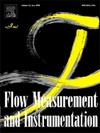基于多频CCEIT系统的气液两相流空隙率测量
IF 2.3
3区 工程技术
Q2 ENGINEERING, MECHANICAL
引用次数: 0
摘要
本文提出了一种基于多频电容耦合电阻抗层析成像(MFCCEIT)系统的气液两相流空隙率测量新方法。该方法综合了阻抗谱的统计特征和频率特征,充分利用了流体阻抗的多频数据。提出了一种新颖的特征提取方法。将统计特征分析与阻抗谱分析相结合,建立了与孔隙率密切相关的多频阻抗数据的统计特征与频率特征相结合的混合特征向量。首先,采用电极对分组和频率范围分割等数据预处理步骤;随后,研究了多频阻抗数据的统计特性和频率特性。相应的,建立了由多频阻抗平均标准差和各流型阻抗谱拟合参数组成的混合特征向量。对混合特征进行对比研究,寻求最适合的数据挖掘算法,并将所提出的特征提取方法与高斯过程回归(GPR)算法相结合,得到原始的空隙率测量方法,建立准确的空隙率测量模型。实验结果表明了该方法的有效性和潜力。气泡流、环状流和分层流条件下,孔隙率测量方法的最大绝对误差分别为1.79%、1.91%和1.61%,均方根误差(rmse)分别为0.0046、0.0064和0.0053。研究结果还表明,该方法优于传统的单频方法,突出了多频测量采集和特征提取方法在充分挖掘和利用流体阻抗信息方面的贡献。本文章由计算机程序翻译,如有差异,请以英文原文为准。
Void fraction measurement of gas-liquid two-phase flow based on a multi-frequency CCEIT system
This work proposes a novel void fraction measurement method of the gas-liquid two-phase flow based on a multi-frequency capacitively coupled electrical impedance tomography (MFCCEIT) system. The proposed method fully leverages the multi-frequency data of the fluid impedance by integrating the statistical and frequency features of the impedance spectroscopy. An innovative feature extraction approach is presented. It combines statistical feature analysis and impedance spectroscopy analysis to develop a hybrid feature vector consisting of both the statistical features and frequency features of the multi-frequency impedance data that are closely correlated with the void fraction. Firstly, data preprocessing steps including electrode pair grouping and frequency range segmentation are employed. Subsequently, the statistical and frequency characteristics of the multi-frequency impedance data are investigated. Correspondingly, a hybrid feature vector consisting of the average standard deviations of the impedance across multiple frequencies and the impedance spectroscopy fitting parameters is established for each flow pattern. Comparison study is conducted to seek the best fit data mining algorithm for the hybrid features, and the original void fraction measurement method combining the proposed feature extraction approach and the Gaussian Process Regression (GPR) algorithm is obtained to develop accurate void fraction measurement models. Experimental results show the effectiveness and potential of the proposed method. Under bubble flow, annular flow and stratified flow, the maximum absolute errors of the void fraction measurement method are 1.79 %, 1.91 % and 1.61 %, respectively, and the root mean squared errors (RMSEs) are 0.0046, 0.0064 and 0.0053, respectively. The research results also show that the proposed method outperforms the traditional single-frequency methods, highlighting the contributions of the multi-frequency measurement acquisition and the feature extraction approach in fully mining and utilizing the fluid impedance information.
求助全文
通过发布文献求助,成功后即可免费获取论文全文。
去求助
来源期刊

Flow Measurement and Instrumentation
工程技术-工程:机械
CiteScore
4.30
自引率
13.60%
发文量
123
审稿时长
6 months
期刊介绍:
Flow Measurement and Instrumentation is dedicated to disseminating the latest research results on all aspects of flow measurement, in both closed conduits and open channels. The design of flow measurement systems involves a wide variety of multidisciplinary activities including modelling the flow sensor, the fluid flow and the sensor/fluid interactions through the use of computation techniques; the development of advanced transducer systems and their associated signal processing and the laboratory and field assessment of the overall system under ideal and disturbed conditions.
FMI is the essential forum for critical information exchange, and contributions are particularly encouraged in the following areas of interest:
Modelling: the application of mathematical and computational modelling to the interaction of fluid dynamics with flowmeters, including flowmeter behaviour, improved flowmeter design and installation problems. Application of CAD/CAE techniques to flowmeter modelling are eligible.
Design and development: the detailed design of the flowmeter head and/or signal processing aspects of novel flowmeters. Emphasis is given to papers identifying new sensor configurations, multisensor flow measurement systems, non-intrusive flow metering techniques and the application of microelectronic techniques in smart or intelligent systems.
Calibration techniques: including descriptions of new or existing calibration facilities and techniques, calibration data from different flowmeter types, and calibration intercomparison data from different laboratories.
Installation effect data: dealing with the effects of non-ideal flow conditions on flowmeters. Papers combining a theoretical understanding of flowmeter behaviour with experimental work are particularly welcome.
 求助内容:
求助内容: 应助结果提醒方式:
应助结果提醒方式:


